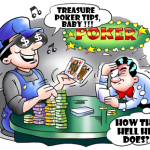
Over the last few years, poker has grown to become the world’s favorite game. Players’ number is growing at a phenomenal rate and there are two main reasons for this: online poker and TV Coverage. There is no doubt that there is a lot of money to be made by playing poker. Many people believe that it is a game of luck, but this couldn’t be further from the truth. Poker is a game of skill and poker strategy maximizes the chances of winning.
There are two categories of players in poker: a bad player is regarded as a Fish (someone who doesn’t have a strategy, relies on luck and plays against the odds) and a good player (which knows the strategies) is regarded as a Shark.
The foundation for many poker strategy topics is David Sklansky’s theorem of poker stating that each time one plays as if he could see his opponent’s cards, he gains, and when his opponent plays differently from the way he would if he could see your cards, you gain.
There are several poker strategies and theories needed to play winning poker such as: limit or no limit holdem strategy, razz strategy, short handed poker, heads up poker, multi table tournament strategy, rebuy tournament strategy etc.
A poker element of strategy that a lot of players don’t seem to understand is that most decisions are common sense: if one has a good hand, he should bet or raise. If one has a lousy hand, he should check or fold. Optimism is usually not an ideal quality for one to have when deciding whether or not to play a poker hand. All of the talk about tight aggressive play, poker tells, and value betting etc develop from this simple common sense default play.
One of the ways to examine a person’s tendencies when playing poker is looking at how many hands he plays. When playing lots of hands he is considered a “loose” player and a player that plays very few hands is considered “tight”. There is a poker saying according to which “tight is right”. The explanation to this is that if you get into a pot with better cards to begin with, you’ll win more money than you’ll lose on a long term.
One way to examine a player’s poker tendency and that is looking at how often the player raises or bets compared to how often he checks or calls. There are two kinds of players: “aggressive” “passive” .The terms have nothing in common with how many hands someone plays, they only concern raising, betting and checking tendencies.
Another term used quite often in poker is “tilt”, which means to get mad, to bet and raise with nothing. For some reason, many players make stupid plays when they’re mad. Playing in the best online casinos with a player on tilt turns out in a profitable situation but when you’re on tilt, you’re going to probably lose money.
There are also two opposite strategies of playing poker: one is not to speak, look around, and try to hide any tells so as to make it hard for your opponents to “read” you. The other one is to be more open, to chat with the other players during the game. This can aid not only to distract the players’ attention and concentration, but it also works to open up more closed players and to determine them to leak out clues.
Another successful strategy is to have exactly the same reaction each time, or even completely different every time. In each case, the other’s player ability to “read” what you are thinking and doing will be misled. Great results can be achieved like this.
Another aspect of poker is “the art of bluffing”, when a player with a weak hand determines the one with a stronger hand to fold. An important part of bluffing is also represented by the way you can control over your expressions and emotions: hiding the clues or tells, that you show when you pick up a strong hand or a weak hand. If you can keep other players from seeing your strengths and weaknesses you will surely be able to bluff effectively.






There are no comments so far